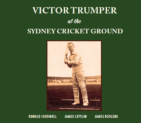The Top 100 Cricketers
Archie Mac |Published: 2009
Pages: 303
Author: Martin-Jenkins, Christopher
Publisher: Allen & Unwin
Rating: 3.5 stars
I love these sorts of books, when a respected cricketing person selects his all time 100. And in Christopher Martin-Jenkens they don’t come much more respected. As CMJ has been alive for just over half the period of Test cricket and for a great part of that life he has dedicated it to writing, watching and covering the great game, his list deservedly carries a lot of weight.
My plan on receiving the book was not to rush in and check the final top ten, but to savour the list, and try and pick the next ten in order, revising each time I read ten and was unsuccessful in matching CMJ’s list (I never picked ten correctly in the whole 100).
Some of the players I was sure would be covered were overlooked, but as Richie Benaud once said – when picking an all time XI – “you can argue with who is not in the team, but you can’t argue with who is in the team.” Still I do not think I will ever forgive CMJ for leaving out my personal hero Clem Hill. The author in both his introduction and conclusion mentions his constant ambivalence over who to leave out, and I am sure he agonised over both his final 100 and the order in which they ultimately appear.
The last time a top 100 was produced from players throughout history was The Times 100 Hundred Greatest Cricketers by John Woodcock which appeared in 1998. The biggest talking point in Australia at the time of Woodcock’s offering was his placing of WG at No.1 and ‘Our Don’ at No.2. Despite the lapse of over ten years the top ten are remarkably similar (I won’t spoil it by divulging the winner).
One thing both the casual cricket fan and the cricket tragic love to do is debate the merits of contrasting great players; Warne V Tendulkar. Lillee V Hadlee, and one of the new debates, the merits of Sobers V Kallis.
In all three of the above, the author is clear in his rating, with Warne and Tendulkar finishing nine apart. Lillee and Hadlee six apart and Sobers and Kallis 49 apart. Although the last would be no real surprise for those who purport to know their cricket (again you will have to buy the book to find the results).
These books with their truncated pen portraits are out of necessity unfulfilling in their descriptions. With CMJ confined to a few playing highlights and some impressive statistics, the reader often finds himself wanting to read more, or for the inclusion of a favourite anecdote. That small criticism apart, the author has done a fine job in providing an interesting and informative narrative on all of his Top 100.
This is one of those books that will entertain both cricket enthusiasts and those with just a parting interest in the game. Generating some good and maybe even heated debate. Strongly recommended.






Leave a comment